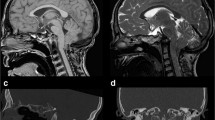Abstract
This report describes an experimental model of chronic tonsillar herniation and its effects on the spinal cord. In ten rats, a small piece of chemically induced mammary cancer was transplanted to the supraoccipital bone. In all cases, the transplanted cancers grew into the posterior fossa, destroying the supraoccipital bone and compressing the cerebellum extradurally. In six of the ten rats, tonsillar herniation was observed at 8–14 weeks after transplantation. Transdural infiltration of the tumor cells was not apparent in any animal. In those rats with tonsillar herniation (n=6), the spinal cord from the C5 to the T8 segments showed enlargement of the central canal without exception. Histological examination revealed the following changes: stretching and thinning of the ependymal cells; swelling of the astrocytic processes; and extracellular edema, predominantly in the dorsal gray matter, but also in the ventral inner portion of the dorsal column. In the control group (n=4) and those rats without tonsillar herniation (n=4), such histological changes of the spinal cord were not observed. Although the lesions can not be regarded as representing mature syringomyelia, they most likely constitute an earlier evolutionary stage.
Similar content being viewed by others
References
Ball MJ, Dayan AD (1972) Pathogenesis of syringomyelia. Lancet II: 799–801
Becker DP, Wilson JA, Watson GW (1972) The spinal cord central canal: response to experimental hydrocephalus and canal occlusion. J Neurosurg 36: 416–424
Boulay G, Shah SH, Currie JC, Longue V (1974) The mechanism of hydromyelia in Chiari type 1 malformations. Br J Radiol 47: 579–587
Chumas PD, Armstrong DC, Drake JM, Kulkarni AV, Hoffman HJ, Humphreys RP, Rutka JT, Hendrick EB (1993) Tonsillar herniation: the rule rather than exception after lumboperitoneal shunting in the pediatric population. J Neurosurg 78: 568–573
Dohrmann GJ (1972) Cervical spinal cord in experimental hydrocephalus. J Neurosurg 37: 538–542
Elster AD, Chen MYM (1992) Chiari I malformations: clinical and radiologic reappraisal. Radiology 183: 347–353
Gardner WJ (1965) Hydrodynamic mechanism of syringomyelia: its relationship to myelocele. J Neurol Neurosurg Psychiatry 28: 247–259
Hinokuma K, Ohama E, Oyanagi K, Kakita A, Kawai K, Ikuta F (1992) Syringomyelia. A neuropathological study of 18 autopsy cases. Acta Pathol Jpn 42: 25–34
Hochwald GM, Lux WE (1972) Experimental hydrocephalus. Changes in cerebrospinal fluid dynamics as a function of time. Arch Neurol 26: 120–129
Huggins C, Grand LC, Brillantes FP (1961) Mammary cancer induced by a single feeding of polynuclear hydrocarbons, and its suppression. Nature 189: 204–207
Ito M (1976) Significance of shunting operation for compensated hydrocephalus — Experimental study of the ependymal layer with HRP and electron microscopy. Neurol Med Chir (Tokyo) 16: 227–236
Kosary IZ, Braham J, Shaked I, Tadmor R (1969) Cervical syringomyelia associated with occipital meningioma. Neurology 19: 1127–1130
Melaurin RL, Bailey OT, Schurr PH, Ingraham FD (1954) Myelomalacia and multiple cavitations of spinal cord secondary to adhesive arachnoiditis. Arch Pathol 57: 138–146
Milhorat TH, Miller JI, Johson WD, Adler DE, Heger IM (1993) Anatomical basis of syringomyelia occurring with hindbrain lesions. Neurosurgery 32: 748–754
Nakamura S, Camins MB, Hochwald GM (1983) Pressure absorption responses to the infusion of fluid into the spinal cord canal of kaolin hydrocephalic cats. J Neurosurg 58: 198–203
Ohta A, Matsubayashi T, Takahara H, Uemae M, Nakayama S (1993) Rat model of bone metastasis obtained by mammary cancer transplantation. Ann Cancer Res Ther 2: 193–198
Oldfield EH, Muraszko K, Shawker TH, Patronas NJ (1994) Pathophysiology of syringomyelia associated with Chiari I malformation of the cerebellar tonsils. J Neurosurg 80: 3–15
Rascher K, Booz KH, Donauer E, Nacimiento AC (1987) Structural alterations in the spinal cord during progressive communicating syringomyelia. An experimental study in the cat. Acta Neuropathol (Berl) 72: 248–255
Sahar A, Hochwald GM, Sadik AR, Ronsohoff J (1969) Cerebrospinal fluid absorption in animals with experimental obstructive hydrocephalus. Arch Neurol 21: 638–644
Sullivan LP, Stears JC, Ringel SP (1988) Resolution of syringomyelia and Chiari I malformation by ventriculoatrial shunting in a patient with pseudotumor cerebri and a lumboperitoneal shunt. Neurosurgery: 744–747
Tachibana S, Iida H, Yada K (1992) Significance of positive Queckenstedt test in patients with syringomyelia associated with Arnold-Chiari malformations. J Neurosurg 76: 67–71
Tachibana S, Harada K, Abe T, Yamada H, Yokota A (1995) Syringomyelia secondary to tonsillar herniation caused by posterior fossa tumors. Surg Neurol (in press)
Takei F, Shapiro K, Hirano A, Kohn I (1987) Influence of the rate of ventricular enlargement on the ultrastructural morphology of the white matter in experimental hydrocephalus. Neurosurgery 21: 645–650
Urasaki E, Soejima T, Yokota A, Matsuoka S (1989) Association of asymptomatic syringomyelia with tentorial meningioma. Neurol Surg 17: 985–989
Weller RO, Wisniewski H, Shulman K, Terry RD (1971) Experimental hydrocephalus in young dogs: histological and ultrastructural study of the brain tissue damage. J Neuropathol Exp Neurol 30: 613–626
Williams B (1969) The distending force in the production of “communicating syringomyelia”. Lancet 26: 189–193
Williams B (1990) Syringomyelia. Neurosurg Clin N Am 1: 653–685
Author information
Authors and Affiliations
Rights and permissions
About this article
Cite this article
Yamazaki, Y., Tachibana, S., Yada, K. et al. Experimental model of chronic tonsillar herniation associated with early stage syringomyelia. Acta Neuropathol 90, 425–431 (1995). https://doi.org/10.1007/BF00294801
Received:
Accepted:
Issue Date:
DOI: https://doi.org/10.1007/BF00294801




